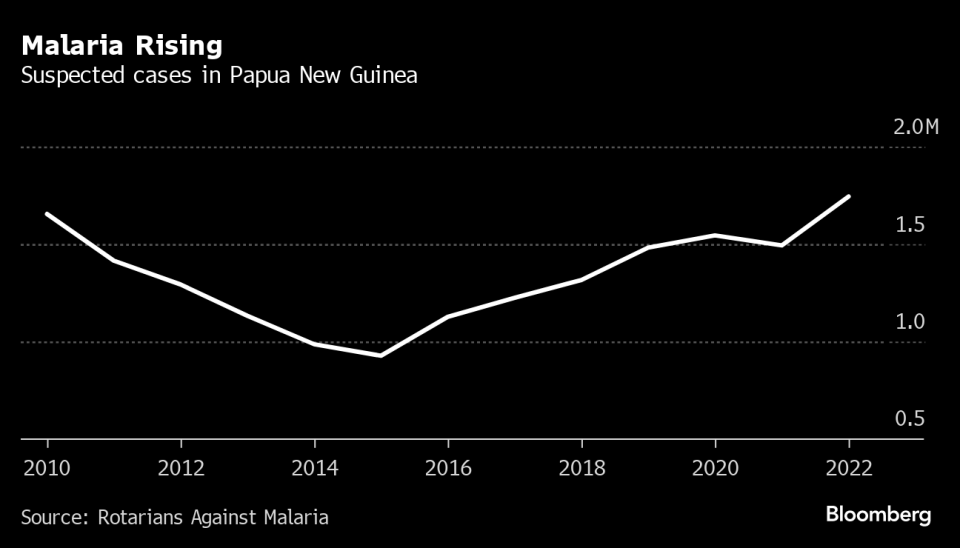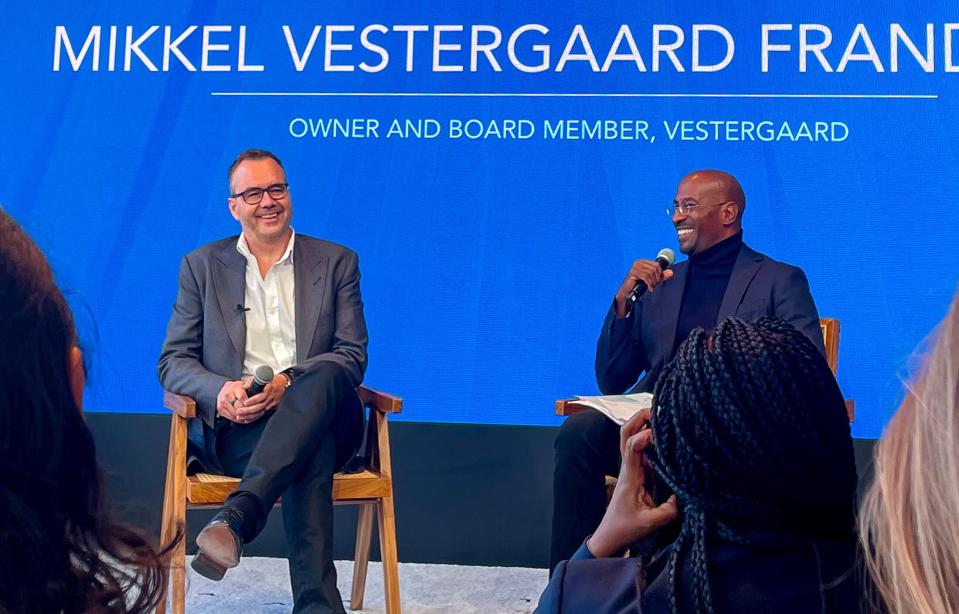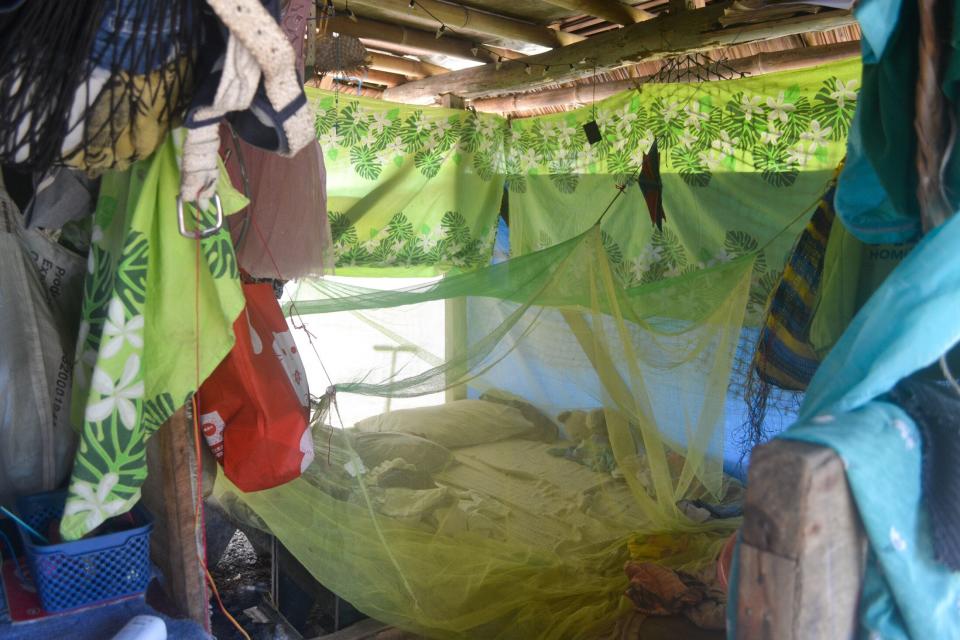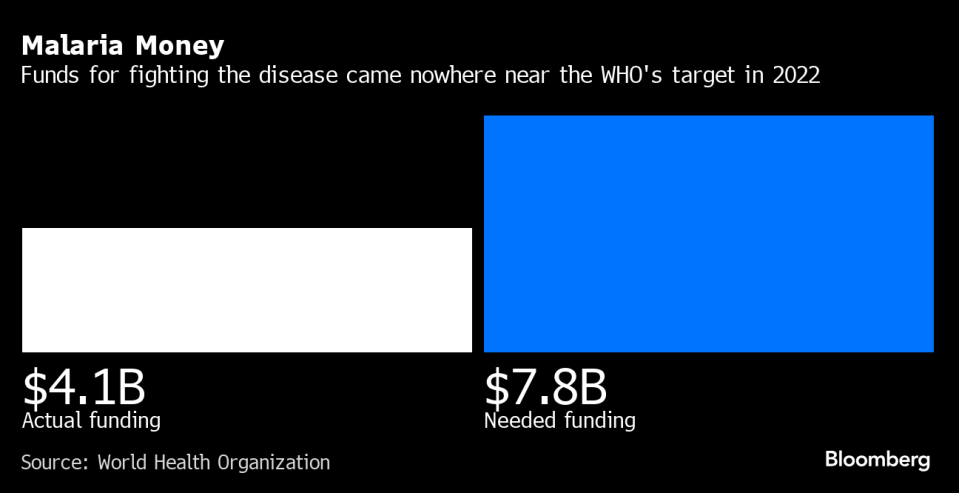One Business Decision Made the World’s Losing Battle With Malaria Even Tougher
(Bloomberg) -- The world is losing its fight against malaria, a disease that has a devastating toll in Asia and Africa and is showing up in developed countries like the US. A single business decision taken by one of the world’s biggest manufacturers of bed nets more than 10 years ago has exacerbated the situation.
Most Read from Bloomberg
Stocks Rally as AI Craze Sweeps Across the World: Markets Wrap
T-Bills Without Tax Bills? This Fund Says It Cracked the Code
AT&T Says Mobile Network Restored as US Starts Investigation
Biden Touts $1.2 Billion in Student Loan Relief With Eye to 2024
Cheap, durable and easy to distribute, insecticide-coated bed nets have for more than two decades been a vital tool in managing malaria, which causes symptoms ranging from a racking cough to kidney failure, and can kill in less than 24 hours. Nets don’t just safeguard the people sleeping underneath — their chemical coatings can quell a contagion and reduce mosquito infestation by killing the insects.
They have been credited with preventing 68% of malaria cases between 2000 and 2015, according to the Bill & Melinda Gates Foundation.
But in the years since, something has gone badly wrong.
“The results were absolutely fantastic,” says Tim Freeman, program manager for Rotarians Against Malaria in Papua New Guinea, now the epicenter for malaria in the Western Pacific. “By 2015, I was thinking we had a chance here. We may have been close to eliminating malaria from this country. Now I don’t see any elimination as possible.”
Papua New Guinea is an object lesson for other nations in how easily a disease management strategy can go off the rails. Achingly beautiful and desperately poor, the island nation sits off the northeastern coast of Australia and is home to more than 10 million people. Researchers first noticed a dramatic surge in malaria cases there in 2017. By 2022, PNG was grappling with an 88% spike in infections.
Listen to the Big Take podcast on iHeart, Apple Podcasts, Spotify and the Bloomberg Terminal. Read the transcript.
PNG isn’t the only place where cases have soared: The World Health Organization estimates there were about 249 million infections globally in 2022, including 608,000 deaths, far exceeding levels before the Covid-19 pandemic. Faltering funding, insecticide resistance and climate change have all been propelling a continued upward trend in global malaria cases, scientists say.
But researchers in PNG say they discovered an additional problem: in the PermaNet 2.0, made by the Swiss company Vestergaard.
The company had changed the chemical coating on the only bed nets used in the country, rendering PNG’s primary defense against mosquitoes vastly less effective, research showed. The change wasn’t disclosed to global health organizations overseeing malaria control, or to those purchasing or relying on the nets.
Interviews with more than three dozen malaria and net experts, as well as business leaders and industry consultants from around the globe, including some who have worked for Vestergaard, show that a burgeoning public health movement against “forever chemicals” coincided with lax oversight of net manufacturing and quality. It took researchers years to figure out that the new coating, which slashed costs and may eventually reduce long-term cancer risks, damaged a key tool in the fight against malaria.
The World Can't Abandon the Fight Against Malaria: Editorial
Vestergaard told Bloomberg that it changed the coating primarily because a supplier discontinued production using the per- and polyfluoroalkyl substances known as PFAS, or forever chemicals. The net maker could have used a more expensive replacement when making the switch and changed other production methods to maintain effectiveness, according to two consultants with knowledge of net technology, including one former Vestergaard employee who asked not to be named.
The company hasn’t acknowledged a decline in efficacy of its nets and said it complied with WHO guidelines, which didn’t require net manufacturers to inform the organization of manufacturing changes until 2017.
Other manufacturers have also run into quality woes, sparking concern that what could be tracked so clearly in PNG is an indication of more widespread challenges ahead as malaria cases continue to rise.
One Billion
In September, Vestergaard celebrated distribution of its one billionth insecticide-treated net. The company gathered corporate leaders, philanthropists and global health officials on the grounds of the United Nations to tout its work.
“We have the tools, we have the innovation,” said Mikkel Vestergaard Frandsen, the former chief executive of the family-owned firm. “Nobody needs to die of malaria anymore.”
Yet researchers in PNG say the tool is failing.
PNG’s mosquitoes largely aren’t insecticide-resistant and the country used PermaNet 2.0 exclusively for years to combat them. That made it a natural laboratory for net research that was hard to do elsewhere.
In 2019, scientists there conducted tests on unused and unopened Vestergaard nets from villages and provincial health clinics around the country, some of which had been produced as far back as 2007. They found that nets made before 2012 — the oldest ones — were all effective, while only 17% of those made more recently passed the test that measures the number of mosquitoes that have died or been incapacitated after exposure to net pieces.
“Our team thought it was a mistake,” said Moses Laman, deputy director of science and research at the Papua New Guinea Institute of Medical Research.
It wasn’t. The researchers, including Freeman and Stephan Karl, head of the entomology lab at the Papua New Guinea Institute of Medical Research, published their findings in 2020 in the journal Nature, but initially struggled to explain why the nets had become so much less effective. It would take another year and a half to make the link to changes in the nets’ chemical coatings.
Carol Essex, a spokesperson for Vestergaard, criticized the researchers’ technique, known as cone tests, and told Bloomberg News that PermaNet 2.0 meets the WHO’s efficacy criteria.
“Cone tests are not designed to directly measure malaria transmission and the resurgence in malaria cases cannot be attributed to the performance of PermaNet 2.0 nets,” Essex said.
The WHO allows for nets to undergo two different tests: a cone test, and if they fail that one, a tunnel test. The tests differ in the time and proximity the mosquitoes are exposed to the insecticide, with a cone test lasting just a few minutes and a larger tunnel test lasting 12 to 14 hours. The researchers in PNG conducted cone tests because they said they are the more stringent of the two. They highlighted cone test results published in 2014 on nets distributed up until 2009 in PNG that were 92% effective.
They followed up their work in Nature with an article in Malaria Journal in November 2022 showing the change in the coating on Vestergaard’s nets led to decreased efficacy. In January 2023, the company released a statement saying: “Any changes made to our products are in line with global regulations and are only implemented after validating that the product fulfills both WHO product specifications and WHO efficacy criteria.”
In August, PNG Health Minister Lino Tom wrote to WHO Director General Tedros Adhanom Ghebreyesus, asking for the organization to form a task force to investigate “mounting evidence” that the nets aren’t as effective as they once were. The WHO, in a statement to Bloomberg, said it “is very concerned by the implications” and has asked for data from the researchers to look into the issue.
Severe Chills
Malaria is an arduous infection that hits children under the age of five and pregnant women the hardest.
In some African countries, the disease reduces GDP growth by about 1.3% a year, the World Bank estimates. While traditionally not thought of as a problem on American soil, nine homegrown malaria infections occurred in the US in 2023, the first cases in 20 years.
About half the world’s population is now at risk of contracting malaria, the WHO reported in its 2023 global malaria report. The agency said that climate change is likely to lengthen malarial seasons in many parts of the world and that mosquitoes in several African countries are growing resistant to a number of different insecticides. Net quality is growing more crucial to fighting the disease because it’s one of the few factors fully under human control.
Nets are usually the primary tool against malaria in the poorest parts of the world. Hannypein, a 23-year-old mother of three in Siar Village in PNG’s Madang Province, values them all the more after a bout of malaria some years ago caused soaring fevers and left her unable to eat or walk for days.
“My first child was only two months old at that time and it really affected both me and my baby,” she said. “I never want any of my children to experience that as well and I ensure that they sleep under the mosquito nets.”
Other companies have also drawn criticism about the quality of their nets. In April, the WHO sent a letter of concern to Germany-based Mainpol GmbH because some of its nets contained too much or too little insecticide. In response to questions, Mainpol sent a link to a WHO inspection document at its manufacturing site in China from May that said “considering the corrective actions taken and planned,” the factory was in compliance with international standards. In 2021, an investigation by the Global Fund to Fight AIDS, Tuberculosis and Malaria found nets made by Tana Netting, a Dubai-based company that’s now defunct, weren’t durable enough.
In 2020, officials in Pakistan received a shipment of bed nets that had too little insecticide and were too small, says Muhammad Mukhtar, Director of Pakistan’s National Malaria Control program. He declined to name the manufacturer, but said they’re blacklisted in Pakistan now.
“It was a big lesson,” Mukhtar says. Researchers have also found that newer nets equipped with two insecticides instead of one also aren’t lasting as long as they should, according to a study published in February in the journal Insects.
Researchers fear these examples, coupled with steep price cuts, point to a deterioration in overall net quality.
“As it’s gotten more competitive, the quality has deteriorated,” Mark Rowland, professor of medical entomology at the London School of Hygiene and Tropical Medicine, said about nets generally. “It’s definitely true the nets have become substandard. You can’t blame them completely because they need to make a profit.”
Back story
Fighting malaria is a priority for prominent philanthropies like the Gates Foundation, international groups and governments, including the President’s Malaria Initiative, an interagency effort in the US. Yet, the total funding — $4.1 billion in 2022 — is well below the $7.8 billion annual target set by the WHO.
The Gates Foundation “has put concerted focus and action into maintaining the impact of effective bed nets,” Philip Welkhoff, malaria director at the organization, said in an email. He didn’t comment on the situation in PNG specifically.
Until the turn of the century, most bed nets didn’t have a built-in coating. Instead, the woven fabric had to be dipped in insecticide every year, said Melanie Renshaw, principal director of the African Leaders Malaria Alliance. Entire villages gathered to do it in communal buckets, a labor-intensive process that many disliked for its feeling of airing dirty laundry.
Japan’s Sumitomo Chemical Co. was the first to create a net that incorporated the chemical coating during manufacturing. It lasted for several years, even when washed, Rowland said. Time magazine listed the net among the best inventions of 2004. Infections and deaths plummeted once a sharp increase in funding allowed more nets to be distributed.
Surging investments in combating malaria brought in new competition for manufacturers. The industry, once dominated by Vestergaard and Sumitomo, swelled with more than a dozen new entrants. Prices plunged as companies cut their costs in order to win contracts. Nets like PermaNet 2.0 that once went for nearly $5 each were available for $1.85.
A Chance Encounter and an Answer
A breakthrough for the PNG researchers didn’t come until 2021. After not getting answers from Vestergaard, Karl, one of the researchers, says he had a chance encounter with someone well-versed in net production. Their discussion led him to look more closely at the insecticide that coated the nets. A lab in Australia confirmed the bonding was changed sometime in 2012 or 2013.
The original coating contained PFAS, dubbed forever chemicals because they’re so slow to break down. While PFAS are still widely used to make shoes and backpacks water resistant and to produce firefighting foams, they’ve been linked to increased cancer risk, decreased fertility and developmental delays in children.
Their use has been restricted in many countries and industries have been seeking alternatives. Vestergaard’s coating supplier discontinued its PFAS product and the bed net maker chose a substitute, which happened to also be much cheaper, according to experts in net manufacturing. Company leaders went on to change the coating, but didn’t inform the WHO, which oversees bed net quality.
“While we are continually looking at ways to make our nets more affordable so that the investment by donors achieves maximal coverage while meeting the WHO standards, the primary reason for the switch in binder was the discontinuation of the ingredient by the supplier,” Essex, Vestergaard’s spokesperson, said.
“As with such parameters in all industries there are acceptable boundaries for performance, and PermaNet 2.0 remains within those boundaries,” Essex said.
PermaNet 2.0 has been used in more than 200 countries around the globe. The impact of less effective nets is unclear in countries that use other brands as well, or where other causes of rising malaria rates play a larger role. But the researchers in PNG — who don’t see climate change or insecticide resistance having as much effect as in other parts of the world where malaria is on the rise — are worried.
“We don’t think this is a PNG problem,” says Freeman, the program manager for Rotarians Against Malaria in PNG. “We think this is a global problem.”
Papua Plea
When the researchers in PNG identified the problems with the Vestergaard nets, they took their concerns to the WHO and other organizations. The Global Fund has sent different brands of nets to PNG, Freeman said, but otherwise they didn’t gain much traction. Those nets aren't any better, he said.
Even if insecticides don’t kill mosquitoes as well as they did before, the nets are still a physical barrier to the disease-carrying insects. Without exception, every one of the people Bloomberg talked to for this story said it was crucial not to undermine support for their broadscale use.
Innovation remains underway, with a few companies including Vestergaard now rolling out new nets with a cocktail of chemicals. Meanwhile, PermaNet 2.0 is still being sold globally. “This is a huge embarrassment,” Freeman said. “They’ve been distributing, for 10 years, lower quality nets than in the past. No one wants to admit that.”
--With assistance from Madison Muller.
Most Read from Bloomberg Businessweek
Plug-In Hybrids Are Booming in the World’s Biggest EV Market
How Capital One’s $35 Billion Discover Merger Could Affect Consumers
US Citizens Become Collateral Damage in Global Sanctions Fight
How Bad Movie Dubbing Led to the Fake Biden Campaign Robocalls
©2024 Bloomberg L.P.






